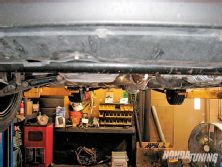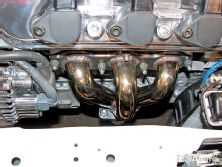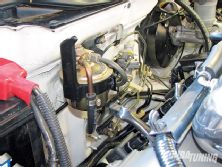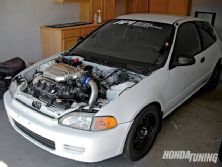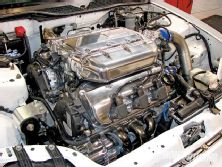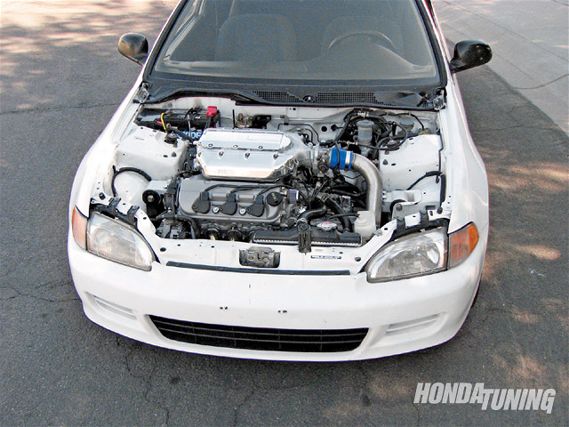 | Honda J-Series Engine Swap - Wrenchin'
| Honda J-Series Engine Swap - Wrenchin'
Forget The K-Series, You Need A J-Series V-6...Now
In case you're not geek enough to get it, TNG refers to The Next Generation, the successful Star Trek remake. Twenty years after Kirk and Spock had trouble with Tribbles, Picard and Ryker battled the Borg, and the entire franchise was reborn. The analogy is there. Really. Honda land's been slow lately. B swaps are far too common to be cool and the K, when done right, is still too pricey; engines and transmissions together are still $4,000. So what do you do when you want all eyes on you or you're just looking to haul some ass? The old hot-rodders say it best: "There's no replacement for displacement," especially 3.5 liters and 24 valves of six-cylinder, VTEC goodness.
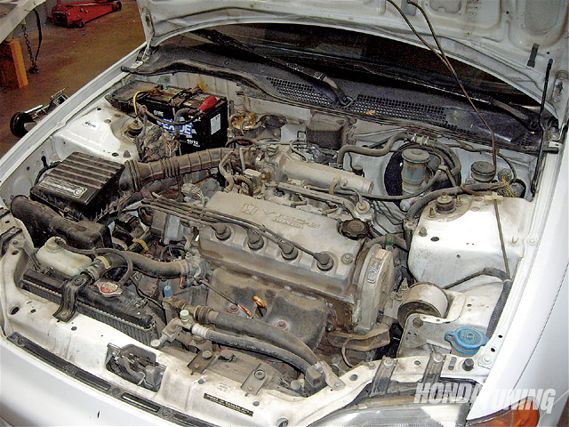 | This perfectly nice '92 Civic VX is about to be gutted to make room for the biggest engine it's ever seen courtesy of a now-in-production V-6 engine swap kit from Arizona Performance Imports.
| This perfectly nice '92 Civic VX is about to be gutted to make room for the biggest engine it's ever seen courtesy of a now-in-production V-6 engine swap kit from Arizona Performance Imports.
Arizona Performance Imports' (API) Tim Beadle has been working with Honda's J-series V-6 for the past three years. Tim was among the first to install one in a sand rail, which means he was among the first to get one to run outside of the engine's OEM chassis. Of course, if you can get a J-series to work in a fabbed-from-scratch sand rail, then dropping a J35A4 into a '92 Civic should be easy. In part, due to the sand rail business's recent downturn, this is exactly what Tim, a 20-plus-year certified Honda mechanic, did.
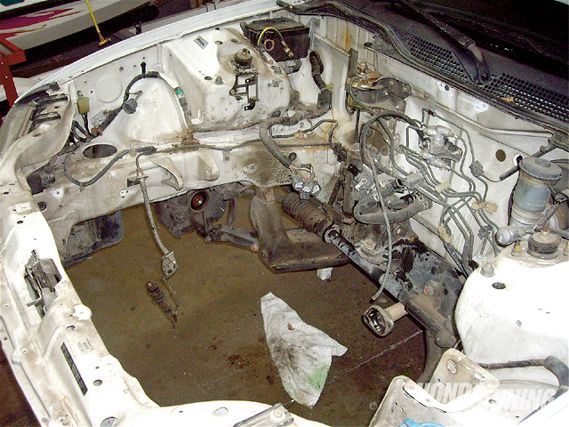 | Remove everything. The J35 V-6 is much larger than the D-series. Heck, it's larger than a K-series. It's amazing that it even fits.
| Remove everything. The J35 V-6 is much larger than the D-series. Heck, it's larger than a K-series. It's amazing that it even fits.
It's difficult to talk about Honda engine swaps without mentioning Hasport though. The project began with modified Hasport mounts, which went through several revisions to get the drivetrain to its final positioning. In the end, ground clearance remains the same and, with the exception of the tachometer and speedometer, you'd swear Honda test-fitted this themselves at some point. Of course, that probably never happened, but it doesn't matter. API now offers everything you need for your own trouble-free V-6 engine swap as does Hasport, who offers power steering-compatible kits for Civic and Integra chassis.
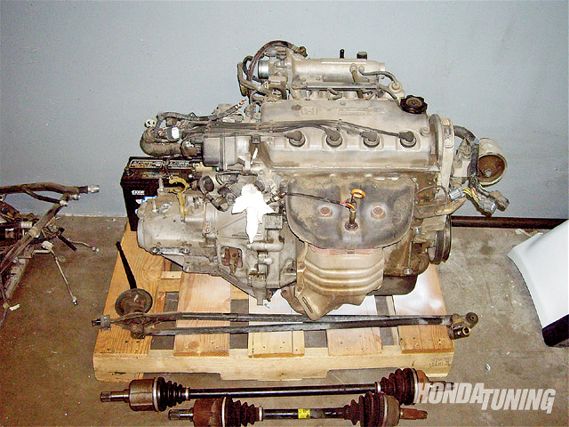 | Depending on what exactly is leaving the bay and what's going in, the J-series could be up to 100 pounds heavier than the outgoing D.
| Depending on what exactly is leaving the bay and what's going in, the J-series could be up to 100 pounds heavier than the outgoing D.
The J-Series: Getting The Right One
Honda's current line of V-6s, the J-series, ranges in displacements from 3.0-3.7 liters. Each has VTEC, some have i-VTEC. While none of them offer the horsepower-per-liter characteristics of some of the best B- or K-series engines, the J-series does offer one thing no Honda four-cylinder engine does--torque. And lots of it. To further the case for the V-6, there're simply a ton of them out there. Today, there are 13 different J35 engines and few of them are terribly expensive. Look around; an Odyssey minivan's J35A4 can go for as low as $900. You simply cannot argue with 240 hp combined with Honda reliability for less than a grand. There's bad news though and it has to do with the transmission. API's swap kit currently supports only the manual transmission. An automatic kit is coming since there're far more automatic transmissions out there, despite how weird it may seem at first to go from a manual trans to an automatic one. Nevertheless, dropping an automatic J35A into the wife's sedan is enough to reinvent grocery getting.
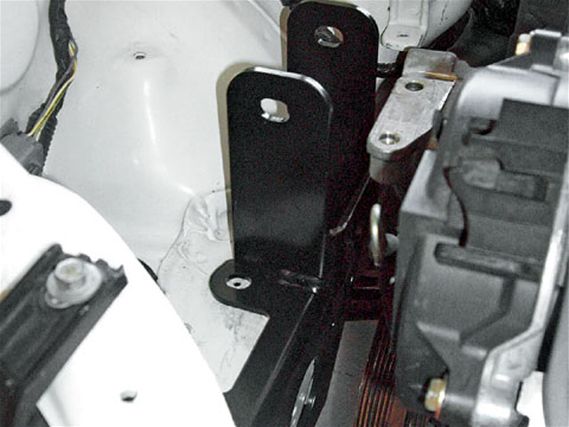 | The new right-side engine bracket goes here and must be welded to the frame.
| The new right-side engine bracket goes here and must be welded to the frame.
And then there's the J30A. It's smaller and doesn't have the displacement or torque of the 3.5-liter engines nor a coil-on-plug ignition. Despite that, there's a 240hp J30A4 that can be found in the '03-'05 Accord, which has the second best power-per-liter ratio of all. Of course, the '09 TL SH-AWD's J37A4 takes the cake here but one of those will likely require you to slang body parts on eBay.
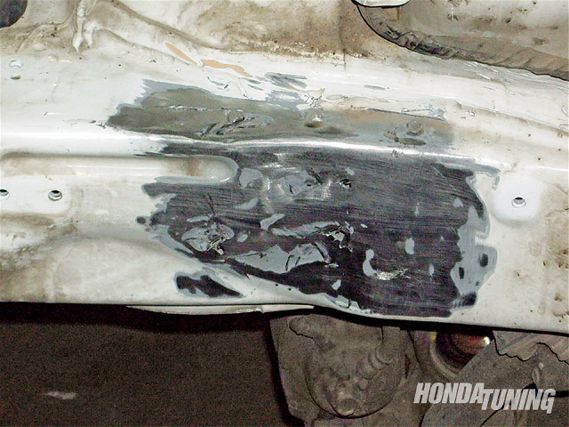 | The Civic's right-side engine bracket used to go here. Drill out its spot-welds and snap it off to remove it. Clean and prep the area around the mount for welding.
| The Civic's right-side engine bracket used to go here. Drill out its spot-welds and snap it off to remove it. Clean and prep the area around the mount for welding.
The J32A is another good choice. These can be found in various '99-'07 CL and TL chassis, including the Type S. There're plenty of these out there, with the Type S and newer engines being the next logical steps up. Like the older Accord's J30A1, pre-'00 engines have distributor ignitions. The good news is that the Type S' extra power comes from a different intake manifold, cylinder heads, and camshafts, all of which can swap over to any '98-'02 non-Type S J30A or J32A. The Type S' intake manifold is similar to the GS-R's, Prelude's, and NSX's dual-stage versions but isn't as important as the heads and cams.
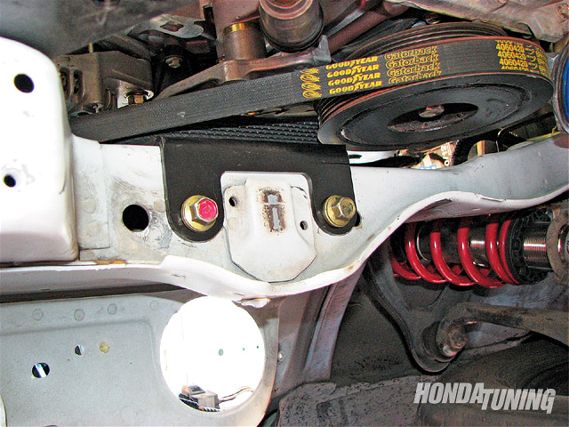 | Here's a view of the right-side bracket from underneath. It's held in place by the original mount's bolts but must still be welded.
| Here's a view of the right-side bracket from underneath. It's held in place by the original mount's bolts but must still be welded.
Arguably the easiest engine to find and the best bang for the buck, the '02-'04 Odyssey's J35A4 makes a whole lot of sense. It's rated at 240 hp but that's on 87 octane. Oh, it also already has the Type S heads and intake but with a spacer that helps shift the torque curve down. Honda sold nearly one million of these vans during those three years so finding one is easy. Of course, this is the engine API used in its '92 Civic.
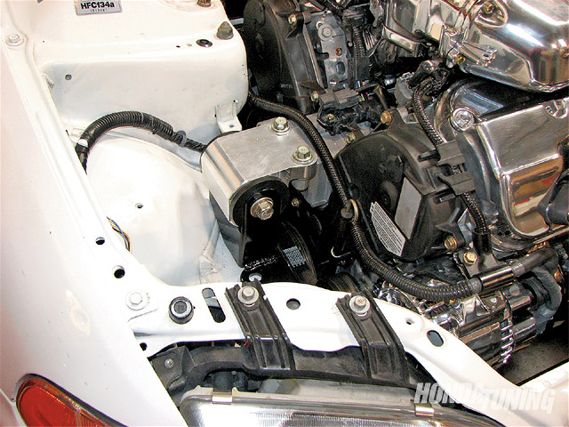 | With the billet mount in place it looks as familiar as any other swap.
| With the billet mount in place it looks as familiar as any other swap.
As you might expect, the newer engines present installation challenges of their own. First, there's the drive-by-wire throttle. Every '03-and-newer Accord and MDX has an electronic throttle as do all Odysseys, Pilots, and Ridgelines, beginning with '05, and the '04 and up TL. It'll work, but the donor engine's corresponding harness, ECU, and accelerator pedal must all be used. Reverting back to a non-drive-by-wire setup is an option, but this requires the appropriate throttle body, cable, and ECU, all of which costs more money. It goes without saying that these newer, drive-by-wire engines are more expensive, even from the junkyards.
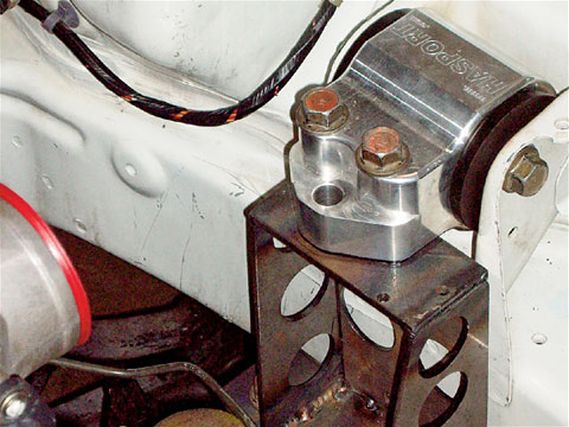 | The left-side bracket is much simpler. It's little more than a riser and another familiar-looking billet mount.
| The left-side bracket is much simpler. It's little more than a riser and another familiar-looking billet mount.
The exhaust system is the other problem. Along with the drive-by-wire throttle, Honda developed integrated exhaust manifolds for the newer J-series, which is basically one big exhaust port that hangs off the back of each head. Today, there are no downpipes offered for these applications since the catalytic converters bolt directly to the heads, but who knows what tomorrow will bring.
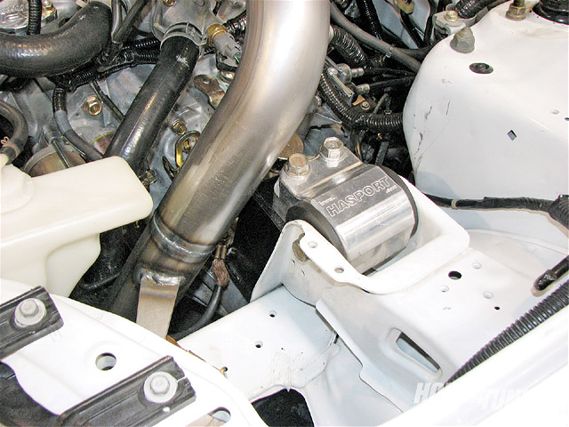 | Honda J-Series Engine Swap - Wrenchin'
| Honda J-Series Engine Swap - Wrenchin'
Oh, and about the available manual transmissions, such gearboxes can be found only in the '03 and newer Accord V-6 or any of Acura's Type S vehicles. Honda didn't begin producing these until '03 and, even once they did, they only account for roughly five percent of its total J-series transmission production. Have fun finding one. Both have six gears and are identical save for the Type S' mechanical limited-slip differential. But hunting for a Type S tranny won't seem all that bad when considering the amount of torque you'll be expecting your 2,600-pound Civic chassis to handle.
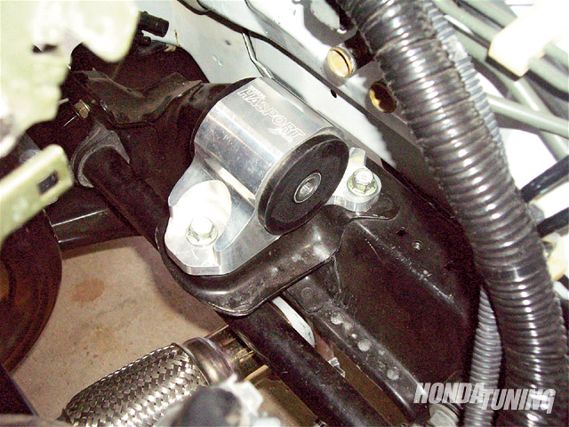 | Out back is just as easy--simply bolt on another billet mount and a custom bracket made specifically for the J-series.
| Out back is just as easy--simply bolt on another billet mount and a custom bracket made specifically for the J-series.
The Wiring: No, It's Not Easy
Ah, but this is a can of worms. The tough part is integrating the J-series engine harness with the Civic's chassis harness. It's no surprise that the plugs are different, but the J's engine harness will also most likely be from an automatic. And, of course, the newer ECUs all have immobilizers. First, sort out the ECU. To make things simple, get a non-drive-by-wire engine along with its matching ECU. Other ECUs can be used, but what does and doesn't work is still being sorted out. To avoid the immobilizer hassle, be sure to get the key and immobilizer ring with the ECU. The ECU doesn't need to match the engine, but the key and ECU do need to match one another. If obtaining an ECU with its matching key isn't an option, the ECU can be reprogrammed at most Honda dealerships. Simply bring in the title and most dealers will reprogram the ECU to match a new key. The immobilizer can then be wired appropriately and taped next to the ECU along with the key. You won't need to access these unless something goes wrong.
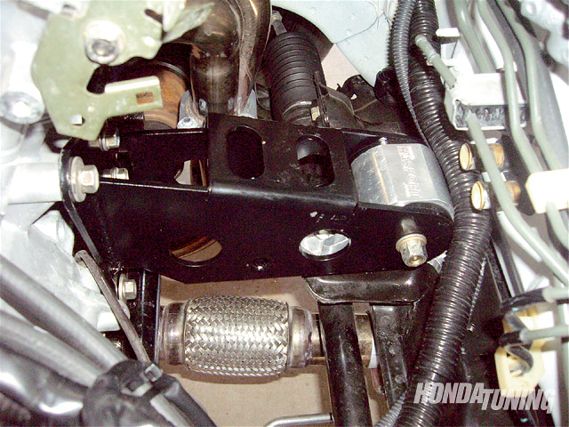 | Honda J-Series Engine Swap - Wrenchin'
| Honda J-Series Engine Swap - Wrenchin'
The engine harness is next. It's easiest to use the donor engine's harness, but with vans made in Alabama, some Acuras and Accords in Ohio, and some random Japanese stuff thrown in just to make things complicated, there're many harnesses. Some route into the cabin where they connect to the ECU, and some terminate inside the engine compartment, sort of like the '92-'95 Civic. API used an '02-'03 automatic CL harness. If swapping a Type S engine, the Type S harness will be necessary to activate the multi-stage intake manifold. Unfortunately, the harness is loaded with stuff that the automatic transmission needs, so some labor is required to strip things away appropriately. Its power and sensor plugs terminate in the engine bay, while the ECU plugs route into the cabin--like the Civic. This allows API to leave all of the Civic stuff in place and simply wire in the V-6 engine harness.
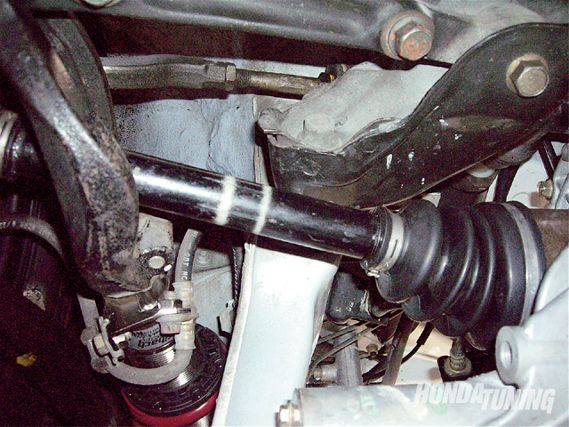 | Axles are another issue. Originally made with the help of Hasport, it took pieces from five separate models to work but API's production kit will be offered with off-the-shelf pieces.
| Axles are another issue. Originally made with the help of Hasport, it took pieces from five separate models to work but API's production kit will be offered with off-the-shelf pieces.
A great deal of work needs to be done here though. The harness needs power and must be grounded, and connections to the chassis harness need to be made as well as a few other odds and ends. You could sit down with a pair of service manuals for a couple of weeks, or you could call API, who's already figured it all out. API offers a race harness with a pair of power leads, aftermarket tachometer connections, and cooling fan and temperature sensor outputs. It's the same harness API uses on its sand rails but will also work for your Civic. Sending in the Civic engine harness along with the V-6's plus $450 will get you a new purpose-built harness. Add $325 if you're missing the V-6 one.
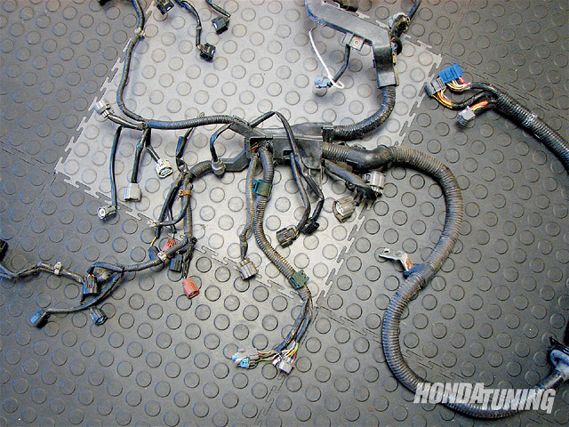 | API uses the OEM automatic CL engine harness because it's easy to get and the least expensive. To modify it for Civic use, API fits it with Civic plugs and connectors, and removes the automatic transmission nonsense. Nearly a third of the wiring is taken out. It takes both the Civic's original harness and the CL's to make it all happen--not too much different than a K swap.
| API uses the OEM automatic CL engine harness because it's easy to get and the least expensive. To modify it for Civic use, API fits it with Civic plugs and connectors, and removes the automatic transmission nonsense. Nearly a third of the wiring is taken out. It takes both the Civic's original harness and the CL's to make it all happen--not too much different than a K swap.
API also offers speed sensor-compatible wiring harnesses, which is a huge bonus. Unfortunately, most ECUs are from automatics, which use different speed sensors than the manuals. Without the appropriate speed sensor input, VTEC won't work and, after running for a short time, will force the engine into limp mode. API has all of this figured out and modifies the harness so that the ECU can get the proper signal. Finally, if you buy the ECU and harness together from API, they'll also deactivate the ECU's immobilizer. API sells the matching ECU for most J-series engines for $325.
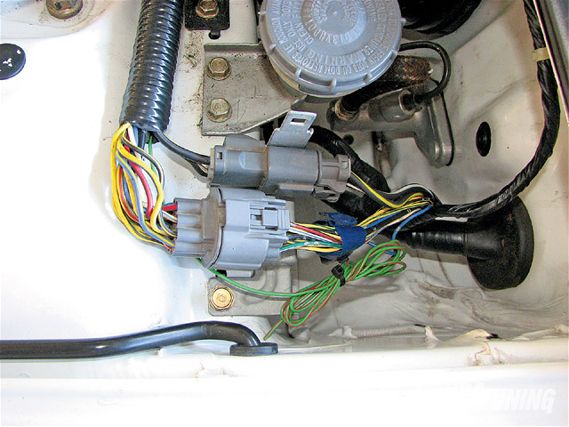 | Behold, a plug-and-play harness. If wiring's not your thing, it's well worth the $450.
| Behold, a plug-and-play harness. If wiring's not your thing, it's well worth the $450.
The Axles And Shifter
The axles began as a combination of about five different OEM pieces but, what with popped joints and broken pieces, a custom set was eventually made. API now offers axles that fit the '92-'00 Civic and '94-'01 Integra. They're good to 300 whp and work with the J's stock manual transmission intermediate shaft, so make sure you get that with your six-speed should you go the manual trans-route. And then there's the shifter. Similar to the H- and K-series swaps, the Js all use cable-operated shifter mechanisms. That means the appropriate cables and shifter box are required. Unlike the K swaps though, OEM Accord K-series shifter cables and shifter boxes work here. Unbelievably, these parts, from an '03-'07 Accord, cost only $250. The tricky part is mounting all of this. The shifter box must be mounted underneath the car and sealed off. Only one of the original mounting bosses can be used. To make it all fit, API offers a mounting plate that securely fastens the box without modifying the console or anything else inside. It's so easy, even your old Civic shift knob will fit.
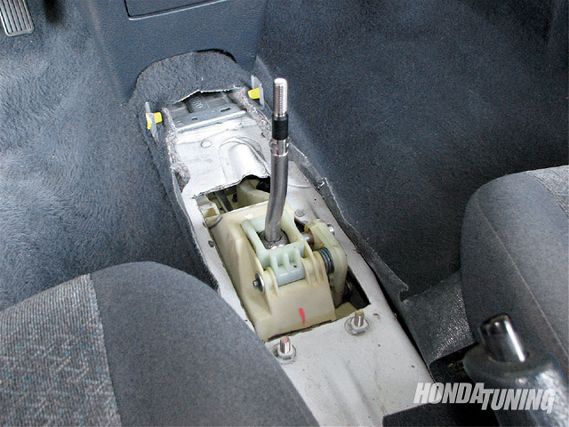 | Stock VX shifter? Not exactly. Unlike Civics that use rod linkages, the J-series uses a cable linkage for shifting. The whole assembly must be replaced. An '03 four-cylinder Accord's shifter and cables are mounted from underneath with a custom mounting and sealing plate. The whole thing costs about $250, but you can keep your Civic's shift knob.
| Stock VX shifter? Not exactly. Unlike Civics that use rod linkages, the J-series uses a cable linkage for shifting. The whole assembly must be replaced. An '03 four-cylinder Accord's shifter and cables are mounted from underneath with a custom mounting and sealing plate. The whole thing costs about $250, but you can keep your Civic's shift knob.
The Install
Surprisingly, bolting in the J-series is as easy a swap as any, perhaps easier. The toughest part is removing the right-side transmission bracket from the frame rail. API started with a '92 VX hatchback, which doesn't have power steering. The API kit mounts the engine far back to take advantage of those missing power steering components. Don't worry though; Hasport's kit works with or without power steering. With the OEM bracket removed, the new API bracket bolts to the framerail's underside using the crash bracket holes as locators. API recommends welding the bracket's perimeter and painting it. The left-side and rear mounting locations don't change, but new brackets must be bolted into place to accommodate the new mounts.
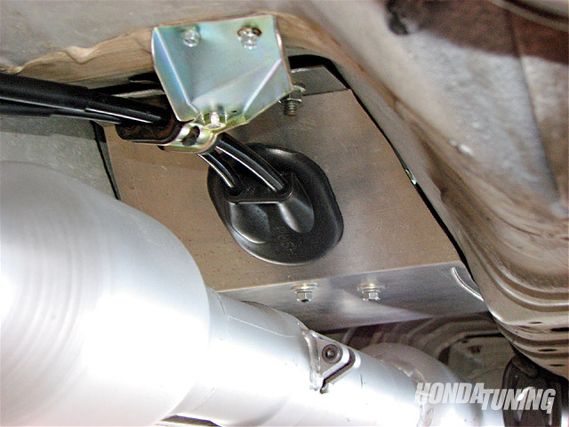 | Everything except the large steel plate is OEM. It's almost as if Honda planned for this.
| Everything except the large steel plate is OEM. It's almost as if Honda planned for this.
Ground clearance is astonishingly ample, with the preexisting subfame being the lowest point. This comes at the expense of hood clearance but, with an engine this big, why hide it? The truth is that a hood hasn't yet been fitted simply because there won't be much left. The good news is that the J35A4 fits, easily, but it's tall. Some custom fabrication, a one-off hood, or even an intake manifold swap will prove to be the remedy.
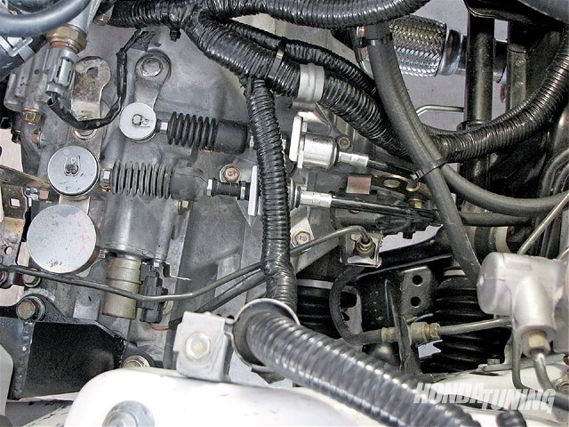 | Honda J-Series Engine Swap - Wrenchin'
| Honda J-Series Engine Swap - Wrenchin'
And then there's the cooling system. Simply move the radiator off to the left side to keep things cool--just like with a K swap--and reuse the original Civic hoses. The API-modified harness operates the fan and provides a signal to the factory temperature sensor just like you'd expect. Air conditioning has yet to be tested, but the fix might be as simple as using an Integra condenser, some custom lines, and a J-series compressor. Time will tell.
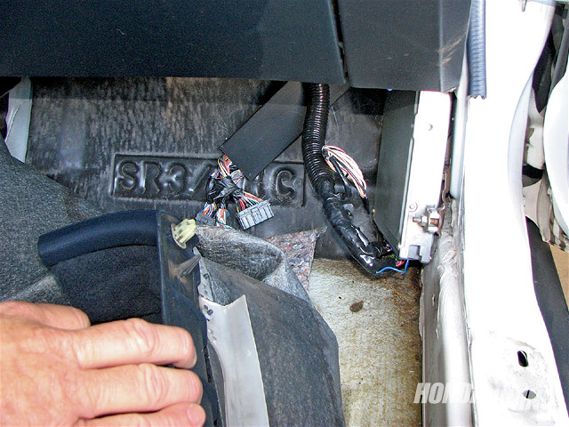 | API modifies the automatic ECU to work with the Civic. The only thing missing is a speed sensor signal (the transmission output is different than what the gauge cluster requires) and a tachometer (six-cylinder vs. four-cylinder). API does provide a signal wire for an aftermarket tachometer though. Notice that the original ECU wiring is still there.
| API modifies the automatic ECU to work with the Civic. The only thing missing is a speed sensor signal (the transmission output is different than what the gauge cluster requires) and a tachometer (six-cylinder vs. four-cylinder). API does provide a signal wire for an aftermarket tachometer though. Notice that the original ECU wiring is still there.
Everything Else
The J-series exhaust is an odd one. Its rear manifold travels forward but makes a 180-degree turn to merge with the front one. API's Civic has OEM-style, Comptech headers that merge into a 2.5-inch catalytic converter where it meets up with a resonator and a small muffler. This makes for all kinds of great noises and is probably enough flow for the low-revving J35A4. Despite that, some additional ponies could likely be found with real headers that eliminate that silly 180-degree bend.
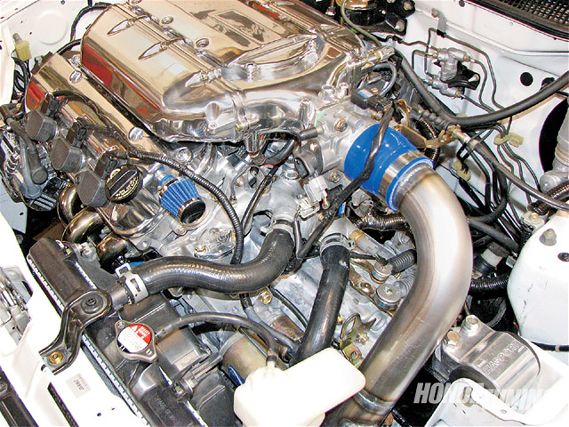 | Believe it or not, the Civic's original radiator hoses can be stretched onto the J's water necks. The radiator must also be moved to the left side.
| Believe it or not, the Civic's original radiator hoses can be stretched onto the J's water necks. The radiator must also be moved to the left side.
Of course, the J-series is heavier than the D-series, even the B-series, possibly by as much as 100 pounds. To compensate, Eibach produced a set of springs for the front that turned out to be a great match. Turn-in is sharp with no noticeable plowing. New springs for the added weight are a must for this swap.
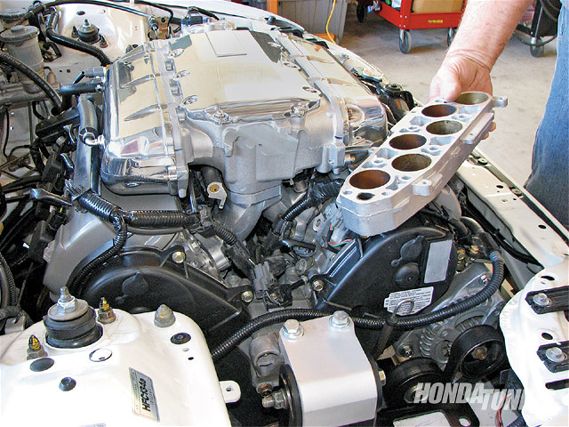 | The J35's intake manifold spacer was removed to help shift the torque curve up. The J's multi-stage intake manifold normally shifts the torque curve down, which isn't a good thing for a Civic that's already struggling for traction in Third.
| The J35's intake manifold spacer was removed to help shift the torque curve up. The J's multi-stage intake manifold normally shifts the torque curve down, which isn't a good thing for a Civic that's already struggling for traction in Third.
It's hard to believe that this swap took so long to happen. The work is really no more difficult than with any other Civic swap, but perhaps with so many good four-cylinder Honda engines, no one bothered looking to the V-6. The truth is that the J-series is an excellent engine that Honda put a great deal of engineering into. It is not a high-rpm, high-horsepower screamer, but judging from the dyno test, there's massive potential here. Plus, once you drive a car with this much torque, four may never again be enough.
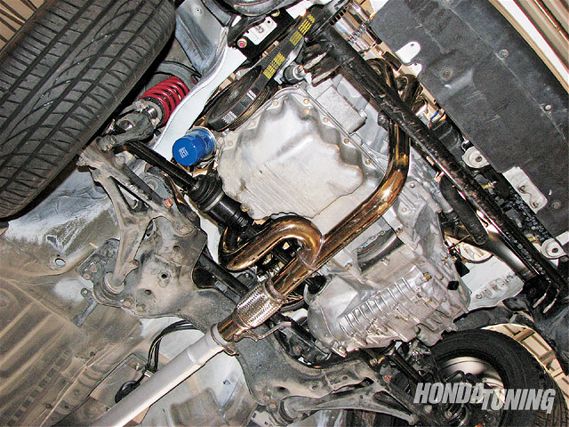 | It even looks like it belongs from underneath. A set of Comptech shorty headers and a cold air intake are the only modifications at this point. With custom front springs from Eibach to compensate for the added weight, distribution measures in at 65 percent up front but nearly perfect from side to side. The best part: It weights less than 2,300 pounds without a driver.
| It even looks like it belongs from underneath. A set of Comptech shorty headers and a cold air intake are the only modifications at this point. With custom front springs from Eibach to compensate for the added weight, distribution measures in at 65 percent up front but nearly perfect from side to side. The best part: It weights less than 2,300 pounds without a driver.
BUT WHAT’S IT COST? THE ESTIMATE J35A4 Odyssey engine $900 Non-LSD six-speed transmission $1100 (add $300 for LSD) API wiring harness mods $450 ECU $325 Shifter assembly $250 Eibach front springs $200 API axles $300 API mount kit $650
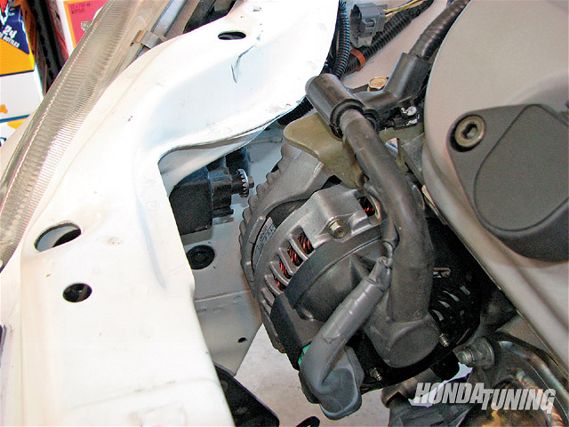 | Clearance issues are minimal. Yes, that's an alternator that clears the headlight housing and a fuel filter that's been left in its original location.
| Clearance issues are minimal. Yes, that's an alternator that clears the headlight housing and a fuel filter that's been left in its original location.
Honda's J-Series: Just The Facts
The J-series is the successor to Honda's ubiquitous V-6, the C-series. First put into the '97 CL and '98 Accord, it's since unofficially became Honda's workhorse. Much like Nissan's VQ, you'll find the J in just about everything. The big difference between the Js and Cs is their angles. The C-series, which includes early Accords, the Legend, and the NSX, features 90-degree-opposed cylinder banks. The J-series measures in at a more compact 60 degrees, which means the heads are closer together and the overall package is smaller. Although there are rare homologations like the J25, the U.S. has only seen variations that range from 3.0 to 3.7 liters. In short, the J-series is excellent. They're all four-valve-per-cylinder, SOHC, configurations with VTEC on their intake sides. They have open-deck blocks with cast pistons and forged crankshafts; some even have forged rods. Prior to the latest 3.7-liter TL SH-AWD engine, they all had 89mm bores with the displacement discrepancies coming from stroke. The Type S engines have the best cams, but the secret is that the J35s feature the same heads and cams as the J32A2 Type S and swapping them over to a non-Type S J-series is entirely doable.
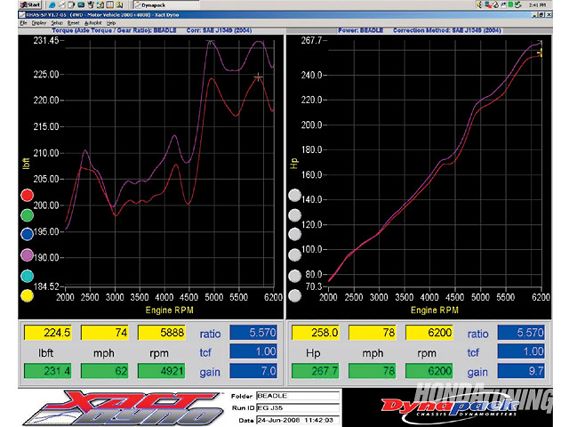 | The J35A4 put down a whopping 267 whp on the Xact Dyno Dynapack with nothing more than a cold air intake. It later laid down 258 whp with a smaller 2.5-inch intake. As you'd expect, the thing is a monster!
| The J35A4 put down a whopping 267 whp on the Xact Dyno Dynapack with nothing more than a cold air intake. It later laid down 258 whp with a smaller 2.5-inch intake. As you'd expect, the thing is a monster!
Look around and you'll find that the Odyssey is the biggest source of J-series engines. There is likely more than a million of these on the road and plenty in the junkyards. The '02-'04 engine is best since it has 30 hp more than the previous J35 and doesn't feature drive-by-wire throttle like the newer models. Finding the transmission is the hard part. Manuals are only available from the Type S Acuras and the '03-and-up Accords. They're both six-speeds and they both have the same ratios but the Type S features a limited-slip differential. Good luck finding one. Let the hunting begin.
J-SERIES RUNDOWN ENGINE/CAR HP NOTES J30A1 '97-'99 3.0 {{{CL}}} {{{200}}} distributor ignition '98-'02 {{{Accord}}} V-6 200 distributor ignition ('98-'99) J30A4 '03-'05 Accord V-6 {{{240}}} A, B, D J30A5 '06-'07 Accord V-6 244 A, B, D J32A1 '99-'03 {{{TL}}} 225 '01-'03 3.2 CL 225 J32A2 '01-'03 CL Type S 260 D ('04 model) '02-'03 TL Type S 260 J32A3 '04-'05 TL 270 A, B, D '06-'07 TL 258 J35A1 '99-'01 {{{Odyssey}}} 210 J35A3 '01-'02 {{{MDX}}} 240 '04-'07 {{{Saturn}}} Vue 250 L66 in GM-speak '03-'04 {{{Pilot}}} 240 J35A4 '02-'04 Odyssey 240 '04 Pilot 240 J35A5 '03-'06 MDX 260 A, B J35A6 '05-'09 Odyssey LX/EX A, B '05 Pilot 255 A, B J35A7 '05-'09 Odyssey EX-L/Touring A, B, CNotes LegendA: Drive By Wire throttleB: Single port exhaustC: Variable Cylinder ManagementD: Six-speed manual transmission availableE: Not compatible with six-speed manual bellhousing

